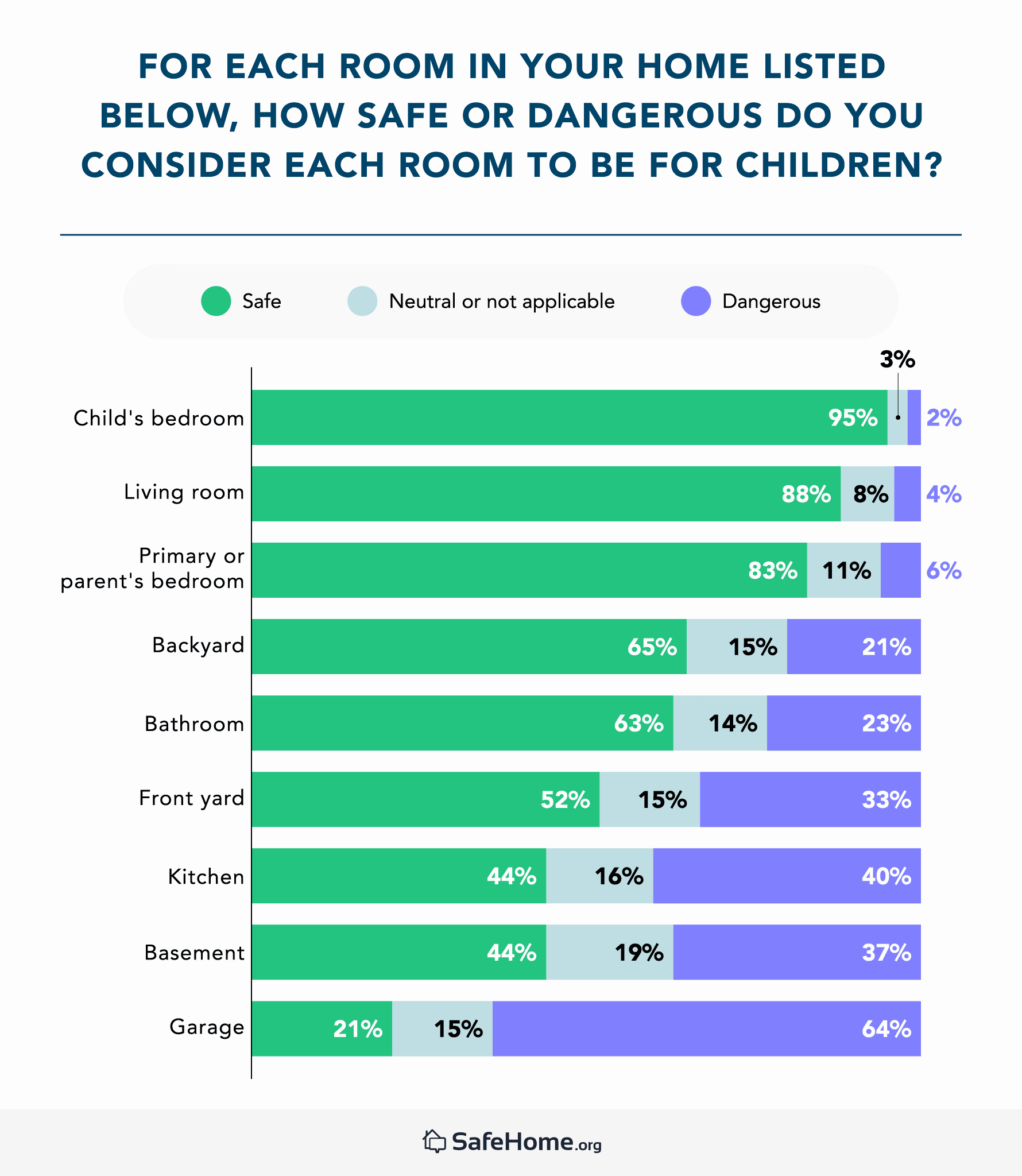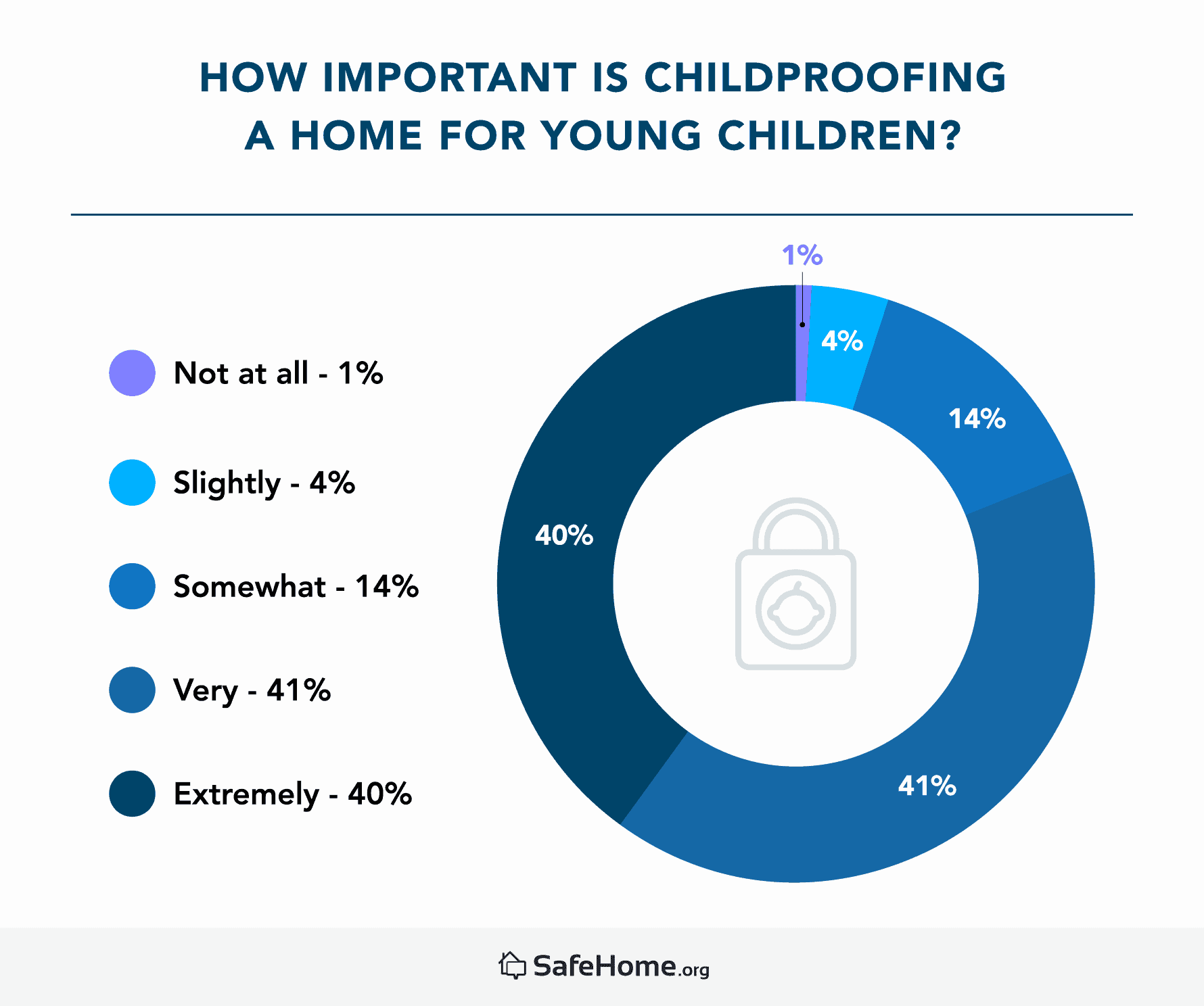2023 Childproofing Report: Biggest Risks and Best Practices for Parents
Every parent’s primary concern is protecting their children from harm, a responsibility made increasingly difficult in a world fraught with myriad dangers. This challenge becomes even more daunting when one recognizes the many perils lurking within one’s home sweet home.
In an effort to help families make their homes as safe as possible, SafeHome.org conducted its second annual study of more than 1,000 parents. Our research revealed their top childproofing tactics and home safety concerns, and here are some of the key findings:
- Parents of young children ranked the garage as the most dangerous room of the home, followed by the basement and kitchen.
- Though parents rated children’s bedrooms as the safest room in the home, injuries from beds or bedding sent nearly 200,000 young children to the emergency room last year.
- The top three childproofing measures among American parents are using safety gates around dangerous areas, locking cabinets and drawers, and installing outlet covers.
- Nearly 60 percent of children 10 and younger have experienced a household injury. According to parents, 55 percent of these household injuries could have been prevented with better childproofing measures.
- Many parents rely on smart home tech to protect their children, and they ranked smart smoke detectors and baby monitors as the most effective devices for safety.
Parents’ Rank Basement as Most Dangerous Room for Children
When asked which areas of the home were most and least dangerous, 95 percent cited children’s bedrooms as a safe spot, and nearly two-thirds concurred that the garage is a highly hazardous spot for kids.
These assessments may have come from first-hand experience: 59 percent of families have had at least one child injured at home. Setting aside these relative room rankings, parents should remember that every area of the house could present risks to kids.
As noted by the parents in our study, garages pose a particular threat – they’re often treacherously messy and overlooked for childproofing while housing sharp tools, hazardous chemicals, and moving vehicles. Basements can be similarly scary due to their dark corners and steep stairs. Kitchens contain sharp implements, heated elements, and whirring appliances of various types. Bathrooms host prescriptions, cleaning agents, and open water fixtures. The front yard often opens on the road, and backyards may have pools or playground equipment. Even bedrooms contain threats that are often overlooked, such as beds and even bedding.
For a clearer perception of wide-ranging threats found throughout the home, families should review the most dangerous products for youngsters. According to the Consumer Products Safety Commission, these household items and fixtures injured the most significant number of young children in 2022:
| Annual emergency room visits caused by injuries from household products or fixtures Among children under 5 |
|
|---|---|
| Stairs, ramps, or landings | 309,321 |
| Beds or bedding | 190,080 |
| Chairs or sofas | 129,999 |
| Other home structures such as walls, counters, doors, floors, or windows | 126,921 |
| Tables | 83,360 |
| Nursery equipment | 75,897 |
| Toys | 74,028 |
| Drug poisoning | 48,573 |
| Other furnishings/fixtures
(Ladders, lamps, mirrors, misc.) |
38,377 |
| Carpets or rugs | 35,723 |
| Cans, bottles, or containers | 34,896 |
| Desks, cabinets, or shelves | 34,844 |
| Bathroom fixtures | 31,874 |
| Household chemicals | 25,597 |
| Appliances | 20,612 |
Note: Each reported injury could have up to three causes
Source: 2022 NEISS Data Highlights, U.S. Consumer Product and Safety Commission
Digesting these numbers can help dispel dangerous misconceptions. For instance, though most parents believe a child’s bedroom is the safest spot in the house, nearly 200,000 children under age five are injured by beds and bedding annually. With these illuminating facts, let’s evaluate how safety might best be improved.
Most Popular Childproofing Methods Among Parents
American parents may differ on politics, education, and religion, yet the need to protectively childproof homes garners widespread support. We found near unanimous agreement that such safeguarding is essential, with 81 percent declaring such measures “very” or “extremely” important.
Mothers in our study felt even more strongly about safety: 85 percent of women rated childproofing as very or extremely important, compared to 76 percent of men.
Preventing every household accident is an impossible goal, yet proper childproofing can make a difference. More than half of parents whose children were injured at home said that safer practices could have avoided recent incidents.
To help families reduce home injuries, we asked parents to share their most insightful and hard-earned childproofing tips.
These were parents’ top five childproofing recommendations according to our analysis:
- Installing safety gates: Curious children will explore everywhere possible once they gain mobility. Safety gates restricting unsafe areas can supply peace of mind when parents aren’t watching. Gates securing staircases were most often mentioned by parents, but blocking risky rooms, corralling kids in safe spaces, or fencing outdoor threats are all excellent uses. Ideally, choose gates anchored by hardware rather than gravity or tension, ensure they are correctly measured to block entry completely and don't choose a style with narrow openings where heads or limbs might get stuck.
- Locking cabinets and drawers: With wee ones about, most drawers and cabinets should be locked so that only adults can open them. Cleaning products, household chemicals, and prescription drugs are apparent dangers to keep out of reach of children. Still, even innocuous everyday items (batteries, pens, or plastic bags) can become hazardous in the wrong hands. Cabinet fasteners come in different styles, including external safety locks, internal latches, or magnetic latches requiring special keys. Whichever you install, ensure they prevent little fingers from accessing (or getting pinched), and keep an eye on clever kids who may decipher the releases.
- Installing outlet covers or plugs: Electrical outlets are placed conveniently for use but horribly for child security. Often found at floor level, a crawling youngster can insert an object and risk electrocution. Several safety options can help protect against such tragedies. Outlet plugs (plastic pieces to fill empty sockets) are the most straightforward solution but can be pried out and become a choking hazard. Better choices include sliding covers that automatically shield open sockets or boxes that enclose the entire outlet (including plugs). Additionally, some parents suggested tamper-proof outlets that kill power when not in use and prevent the insertion of foreign objects. Unplugging appliances from outlets when not in use is another helpful practice that prevents children from playing with cords, avoiding possible strangulation or toppling injuries.
- Securing furniture, rugs, and appliances: Over 18,000 minors are injured each year by falling furniture or televisions. Children pulling on cords, running around rooms, or trying to climb cabinets can be crushed and pinned beneath these heavy objects. Anchoring furniture to the floor or wall with easy-to-install brackets can make a life-or-death difference. For dressers and storage pieces, place heavier contents in lower drawers to provide a better center of gravity. Always mount televisions higher on walls instead of resting them on consoles. Additionally, use two-sided tape or non-slip pads to keep area rugs securely on the floor, minimizing tripping risks.
- Keeping dangerous items out of reach: Parents' simplest shortcut for keeping dangers at bay is using their height advantage. Gates, locks, anchors, and covers help secure hazardous items. Still, these dangerous items (especially when in use) should also rest well out of little ones' reach. Keeping knives, medicine, liquor, tiny items that present choking risks, cluttered handbags, or any other potentially harmful object away from reachable counters and up on high shelves provides an extra level of protection.
Additional parental suggestions (which echo expert recommendations) included placing rubber corner guards on sharp-edged furniture, choosing non-toxic cleaning products when possible, installing door knob covers, locking toilet seats down, using cordless window coverings, and directly communicating about safety precautions and first aid plans rather than relying exclusively on restrictions.
Beyond these traditional household precautions, parents mentioned positive experiences and high expectations for the next generation of technological safety equipment.
Smart Home Tech: The Future of Child Safety
As connectivity advances, so do the methods for controlling homes and keeping tabs on our children. This simplification of childproofing protocol is excellent news for parents who exercise less scrutiny with subsequent kids.
Most parents with multiple children admit to being less cautious with younger offspring than with firstborns. Of course, this likely indicates the relaxation of initial over-protective instincts rather than rising neglect.
Regardless of parental vigilance, modern tools make it easier to monitor and safeguard children. GPS tracking, cell phone accessibility, affordable surveillance, and the Internet of Things have woven a digital umbilical that makes old-school methods seem primitive.
For instance, first-gen baby monitors were essentially walkie-talkies propped up on an infant’s pillow. Modern versions can include high-definition cameras, motion detection, sound isolation, sleep analytics, and Wi-Fi connectivity, allowing app access from anywhere (though beware of hacking dangers).
Many other home safety measures have received tech-powered improvements. Environmental monitors, door locks, and electrical appliances all enable remote supervision. Affordable security cameras and motion detectors allow watching kids from anywhere in the house or the world. GPS devices mean never losing track of a child in a crowd or public place. And when the youngsters are old enough for a cell phone, they’re always a text message away.
When asked how effective next-gen home devices are at keeping children safe, parents showed the most support for smart smoke detectors and baby monitors. Less than half were impressed by smart plugs and motion sensors.
| Rate each of the following home devices based on how effective you believe they are at keeping children safe. | Percentage of parents believing each device is highly effective |
|---|---|
| Smart smoke detectors | 77% |
| Baby monitors | 69% |
| Security cameras | 61% |
| Smart door locks | 59% |
| Video doorbells | 59% |
| GPS trackers for kids | 57% |
| Smart plugs (for controlling appliances) | 47% |
| Motion sensors | 46% |
Before completely subscribing to security gadgetry, parents should also weigh potential dangers and tradeoffs. Connected devices can be susceptible to external manipulation and often present privacy risks. Additionally, over-reliance on high-tech solutions can breed lazy habits and carelessness. There is no Bluetooth substitute for old-fashioned parental attention.
Conclusion
Many parents consider the world full of threats and constantly fret for their children. To counter uncontrollable external dangers, we strive to make our houses safe sanctuaries. Unfortunately, risks persist even within loving, attentive homes.
Despite the fact that 80 percent of American parents consider childproofing very important, nearly 60 percent saw a child hurt at home. More than half of those injuries were viewed as preventable.
A blend of time-tested common sense, new-fangled technology, and statistical awareness may be the best bet for protecting youngsters.
Parents who combine traditional safeguards (fences, locks, anchors, secure outlets) with connected devices (monitors, cameras, detectors), and the awareness that every room has dangerous products to implement a holistic home safety approach will most successfully convert injuries from “preventable” to “prevented.”
Our Data
In October 2023, SafeHome.org conducted an online survey of 1,005 American adults with children aged ten and younger. Researchers asked a series of questions to assess their emphasis on home childproofing practices, their experience with injuries in the home, their assessment of various safety threats, and their opinions regarding commercially available protective devices. The team also solicited open-ended responses seeking suggestions for other parents looking to safeguard their homes and used a text analysis program to discover which safety measures were most popular among parents. Our respondent pool was evenly divided between men and women. 14 percent of parents were 18-29 years old, 67 percent were 30-44 years old, and 19% were 45 or older. 75 percent of parents in the study were white, 11 percent were Black, 7 percent were of multiple ethnicities, 4 percent were Asian, and 3 percent preferred not to answer or were of another ethnicity. 55 percent of parents had just one child, and 45 percent had multiple children.





